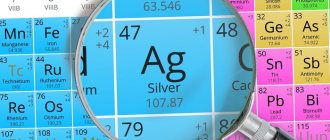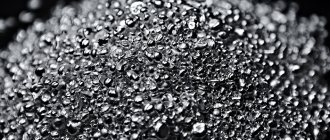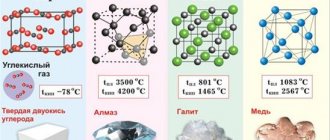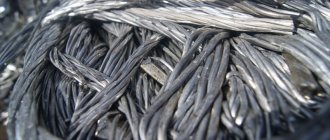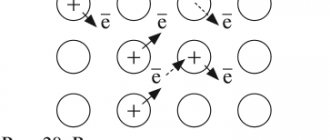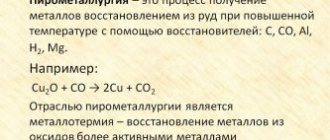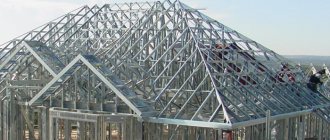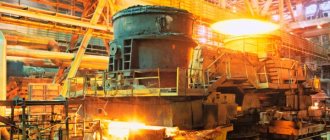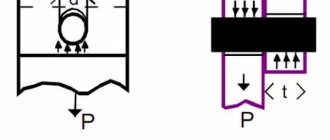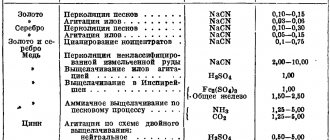In this article:
1. Properties of aluminum
2. Aluminum alloys
3. Raw materials for aluminum production 3.1. Aluminum ores
3.2. Bauxite
3.3. Nephelines
3.4. Alunites
3.5. Other raw materials
3.6. Cryolite production
4. Aluminum refining
Aluminum was first isolated in its free form in 1825 by the Danish physicist Oersted. Currently, aluminum is produced on an industrial scale by electrolytic means. A method for producing aluminum metal by electrolysis of alumina dissolved in cryolite was patented in 1886 independently by Paul Héroux in France and Charles Hall in the USA.
Aluminum production has developed at an extremely rapid pace since then, thanks to the importance that aluminum has acquired in industry. Until 1917, our country did not have its own aluminum smelter, although Russian scientists made a great contribution to aluminum metallurgy. In 1929, aluminum was produced at the Leningrad plant using Volkhov energy and domestic raw materials. In 1932, the Volkhov Aluminum Plant was put into operation, and in 1933, the Dnieper Aluminum Plant. Subsequently, aluminum smelters were built in various regions of our country.
The creation of a powerful energy base allowed our country to quickly become one of the first places in aluminum production.
Properties of aluminum
In its pure form, aluminum is a silvery white metal. One of the important properties of aluminum is its low density: in the solid state (at 20° C) it is 2.7 g/cm3, and in liquid form (at 900° C) it is 2.32 g/cm3. The melting point of high-purity aluminum (99.996%) is 660.24 ° C, the boiling point is 2500 ° C. Important properties of aluminum that determine its use in many areas of industry are its good electrical and thermal conductivity.
Aluminum is well machined, has good malleability, and is easily rolled into the thinnest sheet and wire. In chemical reactions, aluminum is amphoteric. It is soluble in alkalis, hydrochloric and sulfuric acids, but is resistant to concentrated nitric and organic acids. There are three valence electrons in the outer M shell of aluminum, two in the 3s orbital and one in the 3p orbital. Therefore, aluminum is usually trivalent in chemical compounds. However, in some cases, aluminum can lose one p-electron and manifest itself as monovalent, forming compounds of lower valence.
Aluminum production currently includes two main operations:
- obtaining anhydrous aluminum oxide, free from impurities accompanying aluminum, by complex chemical processing of natural compounds (bauxite, clay, kaolin);
- production of aluminum metal by electrolysis of alumina dissolved in cryolite.
Aluminum has many valuable properties: low density—about 2.7 g/cm3, high thermal conductivity—about 300 W/(m • K) and high electrical conductivity of 13.8 • 107 Ohm/m, good ductility and sufficient mechanical strength.
Aluminum forms alloys with many elements. In alloys, aluminum retains its properties. In the molten state, aluminum is fluid and fills molds well; in its solid form, it is easily deformed and can be easily cut, soldered and welded.
The affinity of aluminum for oxygen is very high. During its oxidation, a large amount of heat is released (~ 1,670,000 J/mol). Finely ground aluminum ignites when heated and burns in air. Aluminum combines with oxygen in the air and in atmospheric conditions. In this case, aluminum is covered with a thin (~ 0.0002 mm thick) dense film of aluminum oxide, protecting it from further oxidation; Therefore, aluminum is resistant to corrosion. The aluminum surface is well protected from oxidation by this film even in the molten state.
Melting furnaces for refiners
Refiners use:
- bath-type furnaces without the use of a layer of melting fluxes with additional electromagnetic stirring, as well as with a side loading well (Figure 11);
- rotary (rotary) furnaces with a stationary (fixed) axis of rotation (Figure 12);
- rotary (rotary) kilns with a tilting axis of rotation (tilting rotary kilns) (Figure 13);
- furnaces for processing salt slag, which produce recovered (secondary) fluxes and granulated aluminum;
- wet chip processing equipment;
- other types of stoves (in small quantities).
Figure 11 – Melting furnace with charging well [6]
Figure 12 – Melting rotary furnace with a fixed axis of rotation [6]
Figure 13 – Melting rotary furnace with a tilting axis of rotation [3]
Aluminum alloys
Of the aluminum alloys, duralumin and silumin are the most important.
The composition of duralumin, in addition to aluminum, includes 3.4-4% Cu, 0.5% Mn and 0.5% Mg, no more than 0.8% Fe and 0.8% Si are allowed. Duralumin deforms well and its mechanical properties are close to some types of steel, although it is 2.7 times lighter than steel (duralumin density 2.85 g/cm3).
The mechanical properties of this alloy increase after heat treatment and cold deformation. Tensile strength increases from 147-216 MPa to 353-412 MPa, and Brinell hardness from 490-588 to 880-980 MPa. In this case, the relative elongation of the alloy almost does not change and remains quite high (18–24%).
Silumins are casting alloys of aluminum and silicon. They have good casting qualities and mechanical properties.
Aluminum and alloys are widely used in many industries, including aviation, transport, metallurgy, food industry, etc. Aircraft bodies, motors, cylinder blocks, gearboxes, pumps and other parts in aviation, automotive are made from aluminum and its alloys. and tractor industry, vessels for storing chemical products. Aluminum is widely used in everyday life, the food industry, nuclear energy and electronics. Many parts of our planet's artificial satellites and spacecraft are made of aluminum and its alloys.
Due to the high chemical affinity of aluminum for oxygen, it is used in metallurgy as a deoxidizer, and also for the production of difficult-to-reduce metals (calcium, lithium, etc.) using the so-called aluminothermic process. In terms of total metal production in the world, aluminum ranks second after iron.
Melting furnaces for remelters
Remelters use:
- mainly traditional bath-type melting furnaces without the use of melting fluxes. These are usually reverberatory hearth furnaces of various types: front-loading furnaces, shaft furnaces, inclined (dry) bottom furnaces, etc. (Figures 8-10)
Figure 8 – Bath-type reverberatory melting furnace with front loading [4]
Figure 9 – Shaft melting furnace [5]
Figure 10 – Melting furnace with an inclined hearth and a pit [6]
Raw materials for aluminum production
The main modern method of producing aluminum is the electrolytic method, which consists of two stages. The first is the production of alumina (Al2O3) from ore raw materials and the second is the production of liquid aluminum from alumina by electrolysis.
Aluminum ores
Due to its high chemical activity, aluminum occurs in nature only in a bound form: corundum Al2O3, gibbsite Al2O3 • 3H2O, boehmite Al2O3 • H2O, kyanite 3Al2O3 • 2SiO2, nepheline (Na, K)2O • Al2O3 • 2SiO2, kaolinite Al2O3 • 2SiO2 • 2H2O and other. The main aluminum ores currently used are bauxite, as well as nephelines and alunites.
Bauxite
Aluminum in bauxite is found mainly in the form of aluminum hydroxides (gibbsite, boehmite, etc.), corundum and kaolinite. The chemical composition of bauxite is quite complex. They often contain more than 40 chemical elements. The alumina content in them is 35-60%, silica 2-20%, Fe2O3 oxide 2-40%, titanium oxide 0.01-10%. An important characteristic of bauxites is the ratio of their Al2O3 to SiO2 content by weight - the so-called silicon module.
The silicon module of bauxite supplied to produce alumina must be no lower than 2.6. For medium-quality bauxites, this modulus is 5–7 at 46–48% Al2O3 content, and the modulus for high-quality bauxites is about 10 at 50% Al2O3 content. Bauxite with a higher Al2O3 content (52%) and modulus (10-12) is used for the production of electrocorundum.
Large bauxite deposits in our country include Tikhvinskoye (Leningrad region), Severouralskoye (Sverdlovsk region), Yuzhnouralskoye (Chelyabinsk region), Turgaiskoye and Krasnooktyabrskoye (Kustanay region).
Nephelines
Nephelines are part of nepheline syenites and urtites. A large deposit of urtites is located on the Kola Peninsula. The main components of urtite are nepheline and apatite 3Ca3(PO4)2 • CaF2. They are subjected to flotation enrichment to isolate nepheline and apatite concentrates. Apatite concentrate is used to prepare phosphate fertilizers, and nepheline concentrate is used to produce alumina. Nepheline concentrate contains, %: 20-30 Al2O3, 42-44 SiO2, 13-14 Na2O, 6-7 K2O, 3-4 Fe2O3 and 2-3 CaO.
Alunites
Alunites are the main sulfate of aluminum and potassium (or sodium) K2SO4 • Al2(SO4)3 • 4Al(OH)3. The Al2O3 content in them is low (20-22%), but they contain other valuable components: sulfuric anhydride SO3 (~ 20%) and alkali Na2O • K2O (4-5%). Thus, they, like nephelines, are complex raw materials.
Other raw materials
In the production of alumina, alkali NaOH and sometimes limestone CaCO3 are used; in the electrolysis of alumina, cryolite Na3AlF6 (3NaF•AlF3) and a little aluminum fluoride AlF3, as well as CaF2 and MgF2.
Cryolite production
Cryolite in its natural form is very rare in nature and is produced artificially from fluorspar concentrate (CaF2). The process is carried out in two stages, the first is the production of hydrofluoric acid HF. Finely ground CaF2 is mixed with sulfuric acid in tubular rotary kilns at 200 °C. The reaction takes place in the furnace: CaF2+H2SO4=2HF+CaSO4. Since fluorspar contains SiO2 as an impurity, some volatile fluorosilicic acid H2SiF6 is also formed. Gaseous HF and H2SiF6, after they are purified from impurities, are absorbed in vertical towers by water, resulting in a solution of hydrofluoric acid with fluorosilicic acid. It is purified from H2SiF6 by adding a little soda: H2SiF6 + Na2CO3 = Na2SiF + H2O + CO2. Sodium fluorosilicicate precipitates and purified hydrofluoric acid is obtained. The second stage is the production of cryolite. Al(OH)3 and soda are added to the hydrofluoric acid solution and the so-called cryolite cooking process is carried out, during which the following reactions occur:
6HF + Al(OH)3 = H3AlF6 + 3H2O
2H3AlF6 + 3Na2CO3 = 2Na3AlF6 + 3СO2 + 3H2O.
Cryolite precipitates, it is filtered and dried at a temperature of 130-150 ° C.
Aluminum fluoride is produced in a similar way by adding aluminum hydroxide to hydrofluoric acid until it is completely neutralized: 3HF + Al(OH)3 = AlF3 + 3H2O.
Consumption in industry and life
The figure below shows eight industrial and construction sectors in which aluminum is being used particularly strongly. The percentage shares of various industrial sectors in total consumption are presented according to statistics from the International Aluminum Institute for 2007. Since then, I think the picture as a whole has not changed, and these data are quite relevant.
Application of aluminum in finished industrial products [1]
The main industries that actively use aluminum are:
- Construction
- Product packaging
- Electrical industry
- Transport engineering
- Manufacturing of machinery and equipment
- Production of goods for everyday life
- Powder metallurgy
- Deoxidation of steel in ferrous metallurgy
Aluminum refining
Aluminum extracted from electrolysis baths is called raw aluminum.
It contains metallic (Fe, Si, Cu, Zn, etc.) and non-metallic impurities, as well as gases (hydrogen, oxygen, nitrogen, carbon oxides, sulfur dioxide). Non-metallic impurities are mechanically entrained alumina particles, electrolyte, lining particles, etc. To remove mechanically entrained impurities, dissolved gases, as well as Na, Ca and Mg, aluminum is subjected to chlorination. To do this, a tube is inserted into the vacuum ladle, through which chlorine gas is supplied for 10-15 minutes, and to increase the surface of contact of the gas with the metal, porous ceramic plugs are attached to the end of the tube, ensuring the fragmentation of the gas stream into small bubbles. Chlorine reacts vigorously with aluminum to form aluminum chloride AlCl3. Aluminum chloride vapor rises through the metal layer and suspended non-metallic impurities, some gases and the resulting chlorides Na, Ca, Mg and H2 float up with them.
Next, the aluminum is poured into electric mixer furnaces or reverberatory furnaces, where it remains for 30-45 minutes. The purpose of this operation is additional purification from non-metallic and gaseous inclusions and averaging of the composition by mixing aluminum from different baths. The aluminum is then cast either into ingots on conveyor casting machines or in continuous casting plants into ingots for rolling or drawing. In this way, aluminum with a purity of at least 99.8% Al is obtained.
Higher purity aluminum is produced on an industrial scale by subsequent electrolytic refining of liquid aluminum using the so-called three-layer method. The electrolysis bath has magnesite walls, a carbon hearth (anode) and graphite cathodes suspended from above. The original aluminum is poured into the hearth through a side hole in portions, maintaining an anode layer of a certain thickness here; above it there is a layer of electrolyte made of fluoride and chloride salts, and above the electrolyte there is a layer of purified aluminum, which is lighter than the electrolyte; The ends of the cathodes are immersed in this layer.
In order for the aluminum to be refined to be at the bottom, it is made heavier, forming an aluminum-copper alloy in the anode layer (30-40% Cu is dissolved in the layer). During the electrolysis process, Al3+ ions move from the anode layer through the electrolyte layer to the cathode layer and are discharged here. The pure cathode metal that accumulates on the surface of the bath is scooped out and poured into ingots. This method produces aluminum with a purity of 99.95-99.99%. Electricity consumption is ~ 18,000 kWh per 1 ton of aluminum. Purer aluminum is obtained by zone smelting or distillation through subhalides.
Remelters: features of work
For remelters, the main characteristic is the quality of the charge:
- clean scrap, unoxidized and unpainted
- in most cases - scrap with one type of aluminum alloy.
The metal yield is very high, that is, the metal content ranges from 96% to 100%. Such scrap does not require melting fluxes, which are designed to coat inorganic non-metallic components. A small amount of coating flux is required to protect against oxidation during slag formation. Remelters can use different types of kilns, but the most typical kiln type is a bathtub, gas, and inclined hearth kiln. About 0.15% of the total amount of metal in the loaded charge is converted into oxides. Hot slag removed from the surface of the melt contains about 70% metal, mainly absorbed by the slag. This slag is collected in a steel box, where it is coated with a layer of flux (up to 5% of the volume of removed slag) to prevent oxidation of most of the slag. The final metal content in the cooled slag will be about 60%. This slag is sent for processing to refiners, who melt it under a layer of fluxes.
Construction
Aluminum windows and facades
The main aluminum alloys that are used in the construction industry are alloys 6063 and 6060, as well as alloy 6082 (in Europe) and alloy 6061 (in North America). They have fairly high strength (6082 and 6061 - up to 400 MPa) and good corrosion resistance.
Window aluminum profiles with thermal decoupling (alloys 6060/6063)
The most important structural characteristics of aluminum, which determine the use of aluminum as a material for window and door frames:
- strength for rigidity and safety;
- the ability to take complex shapes (provided by extrusion);
- attractive appearance;
- corrosion resistance;
- minimal need for maintenance.
Curtain facade with aluminum frame (alloys 6060/6063)
Post-transom facade
Aluminum roofing and aluminum cladding of buildings
Decorative and protective profiled cladding materials are often made from rolled aluminum sheets. Various types of decorative and protective coatings make them ideal materials for use as roofing materials.
Application for roofing and cladding of buildings provides the following properties of aluminum:
- low weight due to low density;
- resistance to water;
- corrosion resistance;
- decorative look.
Aluminum roofing
cars and equipment
Heating and ventilation systems
Aluminum alloys of the 3000, 5000 and 6000 series have good thermal conductivity. Combined with high strength, these alloys are a good choice for heating and ventilation applications. These systems include the following components using aluminum alloys:
- compressors;
- condensers/evaporators;
- expansion valves;
- fans;
- pipes.
Properties of aluminum that are important for heating and ventilation systems:
- high thermal conductivity;
- high contact coefficient;
- low density;
- high corrosion resistance.
Wires and cables
The high electrical conductivity of the 1000 series aluminum grades, as well as the 8000 series aluminum alloys, makes them very suitable for the manufacture of electrical conductors. Aluminum conductors are used in the following cases:
- electrical distribution substations;
- power systems of high-rise buildings;
- high-voltage power lines;
- most underground power lines;
- power cables for industrial applications.
Most aluminum in the electrical industry is used in the form of cables (8 out of 13%). However, it is also used in the form of electrical busbars for equipment with high current strength, as well as for powering large buildings. In addition, cables for industrial, commercial and residential buildings may contain many insulated conductors, which are placed in a common protective aluminum sleeve.
Requirements for aluminum used for electrical applications:
- reasonable cost;
- sufficiently high electrical conductivity;
- corrosion resistance;
- strength.
Leading countries in aluminum ore production
The main deposits of aluminum are concentrated in regions with a tropical climate, and most of the 73% of deposits are found in just 5 countries: Guinea, Brazil, Jamaica, Australia and India. Of these, Guinea has the richest reserves, more than 5 billion tons (28% of the world share).
If we divide reserves and production volumes, we can get the following picture:
- 1st place – Africa (Guinea).
- 2nd place - America.
- 3rd place – Asia.
- 4th place – Australia.
- 5th – Europe.
The top five countries in aluminum ore production are presented in the table
| A country | Production volumes million tons |
| China | 86,5 |
| Australia | 81,7 |
| Brazil | 30,7 |
| Guinea | 19,7 |
| India | 14,9 |
Also, the main producers of aluminum ores include: Jamaica (9.7 million tons), Russia (6.6), Kazakhstan (4.2), Guyana (1.6).
